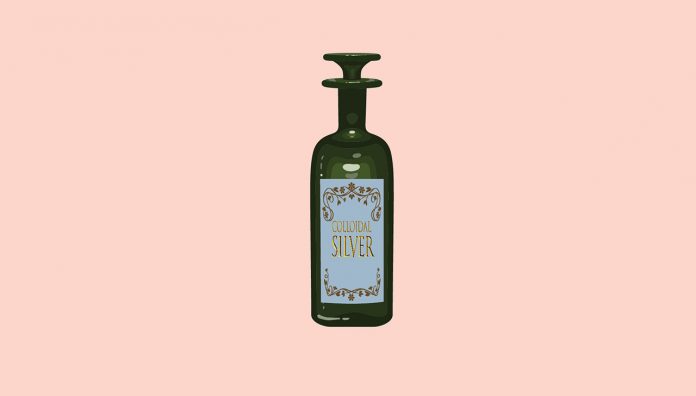When Paul Karason died of a heart attack in 2013, age 62, few noticed. But he had achieved global infamy in 2008 when he appeared on the US morning TV show Today.
The ugly
Why? Mr Karason was blue, literally blue. Persuaded of the healing powers of colloidal silver – minute silver particles suspended in a liquid – Mr Karason concocted and consumed his own brew of water and silver nanoparticles. After several years, he developed an irreversible condition called argyria, a blue-grey discolouration of the skin.1,2
Because of his daily dosing, the silver particles accumulated, ionised in his stomach and were transported to the skin. There they reacted with sunlight, causing the blue discolouration.2
Mr Karason was not alone in his misbelief. Celebrities such as Gwyneth Paltrow espoused alleged health benefits from ingesting colloidal silver.
The supposed benefits range from boosting the immune system to treating cancer, HIV/AIDS, shingles, herpes, eye ailments and prostatitis.1,3
However, no rigorous studies supporting these claims exist.3
The bad
Worse, as Mayo Clinic physician and researcher Dr Brent Bauer notes: ‘Excessive doses of colloidal silver can cause possibly irreversible serious health problems, including kidney damage and neurological problems such as seizures’. Heavy ingestion can also cause bone marrow suppression, hepatotoxicity and acute tubular necrosis. Colloidal silver products also interact with some medicines.2,3
Little wonder, then, that in 1999 the US Food and Drug Administration ruled that products containing colloidal silver ingredients or silver salts were neither safe nor effective.4
Similarly, in 2002 the Therapeutic Goods Administration (TGA) concluded: ‘There are no colloidal silver products approved for supply as medicines in Australia.’5 Both the TGA and the US Health Department’s National Center for Complementary and Integrative Health note that while unsupported by evidence, products marketed as ‘dietary supplements’ are available online.4-6
The good
Silver was once widely used. In AD 78, Pliny the Elder reported that slag from smelting silver ‘has healing properties as an ingredient in plasters’.
According to Herodotus, Cyrus the Great – king of Persia from 550 BC to 529 BC – stayed healthy by drinking only boiled water stored in silver flagons.
During the Middle Ages, monks popularised the use of silver nitrate, a salt formed by reacting silver with nitric acid, to treat ulcers and burns.1,7
As early advocates observed, silver does have antiseptic properties. Until the advent of antibiotics, it was used topically with variable success.8
The exact mechanism by which silver attacks bacterial cells is unclear. Scientists suggest the key is the biocidal effect of heavy metals such as silver. They kill microbes by binding to proteins, thus inhibiting enzymatic activity.9
Today, the biocidal effect is being harnessed anew. Although thorough testing and standardisation of products has not yet been undertaken, silver-containing coatings on medical devices and fabrics can have clinical uses.9
Among these uses are: wound care, bone prostheses, reconstructive orthopaedic surgery, cardiac devices, catheters, surgical appliances and, of relevance to COVID-19, ventilators.10
References
- Pickett, M. Colloidal silver turns you blue—but can it save your life? Wired 2017 Feb 10. At: www.wired.com/story/does-colloidal-silver-work/
- Bracy NA, Zipursky JK, Juurlink DN. Argyria caused by chronic ingestion of silver. CMAJ 2018;190(5):E139. At: www.cmaj.ca/content/190/5/E139.long
- Bauer BA. My dad takes colloidal silver for his health, but is it safe? Mayo Clinic. 2017. At: www.mayoclinic.org/healthy-lifestyle/consumer-health/expert-answers/colloidal-silver/faq-20058061
- US Food and Drug Administration. Over-the-counter drug products containing colloidal silver ingredients or silver salts. Fed Regist 1999;64(158):44653–8. At: www.ncbi.nlm.nih.gov/pubmed/10558603
- Therapeutic Goods Administration. Change to excluded goods order: Colloidal silver products. 19 December 2002. At: www.tga.gov.au/sites/default/files/foi-156-1213-25.pdf
- National Institutes of Health. National Center for Complementary and Integrative Health. Colloidal silver. At: www.nccih.nih.gov/health/colloidal-silver
- Alexander JW. History of the medical use of silver. Surg Infect 2009;10(3):289–92. At: www.liebertpub.com/doi/10.1089/sur.2008.9941
- Chopra I. The increasing use of silver-based products as antimicrobial agents: a useful development or a cause for concern? J Antimicrob Chemother 2007;59(4):587–90. At: pubmed.ncbi.nlm.nih.gov/17307768/
- Lumen Learning. Using Chemicals to Control Microorganisms. At: courses.lumenlearning.com/microbiology/chapter/using-chemicals-to-control-microorganisms/
- Lansdown A. Silver in health care: antimicrobial effect and safety in use. In: Biofunctional textiles and the skin. Hipler UC, Elsner P (eds). Curr Probl Dermatol Basel, Karger 2006;33:17–34. At: www.karger.com/Article/Abstract/93928




 Source: Queensland Health Immunisation Program[/caption]
Source: Queensland Health Immunisation Program[/caption]


 Dr Sarah White[/caption]
Dr Sarah White[/caption]








